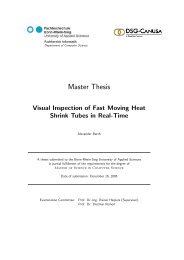Master Thesis - Hochschule Bonn-Rhein-Sieg
Master Thesis - Hochschule Bonn-Rhein-Sieg
Master Thesis - Hochschule Bonn-Rhein-Sieg
You also want an ePaper? Increase the reach of your titles
YUMPU automatically turns print PDFs into web optimized ePapers that Google loves.
4. Overall evading concept <strong>Master</strong> <strong>Thesis</strong> Björn Ostermann page 49 of 126<br />
To record the points, similar to the recording of the background image in chapter 4.3.2, 500 sample<br />
data are taken by the 3D camera. The medians of each targeted pixel is computed and stored. From<br />
those values and the respective values from the robot’s coordinate frame, the transformation matrix<br />
between the camera’s and the robot’s frame is computed, using the algorithm described in chapter<br />
5.5.2.<br />
As with the background, the voxel data acquired in this part can be stored to disk and retrieved later.<br />
This shortens the start up time of the system. Only the voxel positions have to be stored, the<br />
transformation matrix can be easily recomputed after the retrieval of their values in the set up phase.<br />
4.4 Path planning control<br />
The path planning control thread has to compute the solutions described in chapter 2.3. That means it<br />
has to find a path for the robot, on which the working robot avoids the collision with intruding objects<br />
and is still able to achieve its desired goal as far as possible. The primary goal in this task is the<br />
avoidance of collisions.<br />
As shown in Figure 18, the path planning control thread acquires pre-processed data from the camera<br />
control thread. This data contains among others the distance between the robot and objects intruding in<br />
the workspace and the outline of the reachable space.<br />
The path planning control thread combines those data with a set of defined goal positions the robot has<br />
to drive through while working. In this project, to demonstrate the path planning and approach<br />
detection, the robot was given four goal positions that result in a rectangle in front of the robot, by<br />
which it attempts to drive. From the combination of the data the thread calculates the next pose<br />
(position and orientation) the robot has to reach respectively the speed in which the robot can do this,<br />
dependant on the chosen approach (see chapter 4.3.4 – reachable space or distance measurement). The<br />
result is transmitted to the robot control thread (see chapter 4.5) via the data exchange object.














